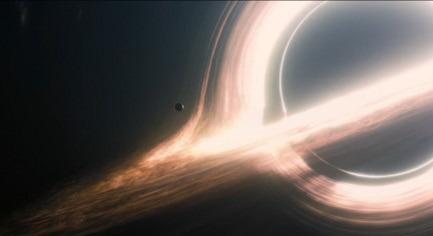Near black holes, space tends to be so deformed that even light rays might curve around them mostly. This phenomenon might allow people to view several versions of the same thing.
 A disk of glowing gas swirls into the black hole “Gargantua” from the movie Interstellar. Because space curves around the black hole, it is possible to look round its far side and see the part of the gas disk that would otherwise be hidden by the hole. Our understanding of this mechanism has now been increased by Danish master’s student at NBI, Albert Sneppen. Image Credit: interstellar.wiki/CC BY-NC License.
A disk of glowing gas swirls into the black hole “Gargantua” from the movie Interstellar. Because space curves around the black hole, it is possible to look round its far side and see the part of the gas disk that would otherwise be hidden by the hole. Our understanding of this mechanism has now been increased by Danish master’s student at NBI, Albert Sneppen. Image Credit: interstellar.wiki/CC BY-NC License.
Although this phenomenon has been known for decades, it is only now that people have got a correct, mathematical expression, owing to Albert Sneppen, a student at the Niels Bohr Institute. The findings of the study, which are highly beneficial in realistic black holes, have recently been reported in the Scientific Reports journal.
People might have heard of black holes — the wonderful lumps of gravity from which not even light can get away. They would also have heard that space itself and even time tend to act oddly next to black holes: space is distorted.
Near a black hole, space tends to curve so much that light rays are deflected, and very proximate light can be deflected so much that it travels several times near the black hole. Therefore, while observing a faraway background galaxy (or other celestial bodies), people might be lucky to view the same image of the galaxy several times, albeit more and more warped.
Galaxies in Multiple Versions
A faraway galaxy tends to shine in all directions — some of its light reaches nearer to the black hole and is lightly deflected; a part of the light even comes closer and circumvolves the hole once before it escapes down to Earth, and so on. While observing near the black hole, people see a higher number of versions of the same galaxy, the closer to the edge of the hole that is being looked at.
The question is how much closer to the black hole do people have to look from one image to view the next image. The study result has been known for more than four decades and is about 500 times (for the math aficionados, it is more precisely the “exponential function of two pi,” written e2π).
So far, calculating this is so hard and a physical and mathematical intuition has not yet been developed as to why it occurs to be this factor. However, by making use of some smart, mathematical tricks, master’s student Albert Sneppen from the Cosmic Dawn Center — a fundamental research center under both the Niels Bohr Institute and DTU Space — has successfully demonstrated why.
There is something fantastically beautiful in now understanding why the images repeat themselves in such an elegant way. On top of that, it provides new opportunities to test our understanding of gravity and black holes.
Albert Sneppen, Student at Niels Bohr Institute, University of Copenhagen
Mathematically proving something is not just pleasing in itself; in fact, it brings people closer to an insight into this wonderful phenomenon. The factor termed “500” arises directly from how gravity and black holes function, so the repetitions of the images have currently become a method to study and test gravity.
Spinning Black Holes
Considering it as a completely new feature, Sneppen’s technique can also be generalized to apply not only to “trivial” black holes but also to black holes that rotate. Which, indeed, they all do.
It turns out that when the it rotates really fast, you no longer have to get closer to the black hole by a factor 500, but significantly less. In fact, each image is now only 50, or 5, or even down to just 2 times closer to the edge of the black hole.
Albert Sneppen, Student at Niels Bohr Institute, University of Copenhagen
Looking around 500 times nearer to the black hole for every new image means that the images are rapidly being “squeezed” into one annular image. Essentially, many images will be hard to observe.
However, when black holes tend to rotate, there is more scope for the “extra” images, so people can hope to verify the theory observationally in a not-so-distant future. In this method, people can learn not just about black holes, but also about the galaxies behind them.
The travel time of the light increases, the more times it has to go near the black hole, so the images turn out to be increasingly “delayed.” For instance, if a star explodes as a supernova in a background galaxy, one can see this explosion repeatedly.
Journal Reference:
Sneppen, A (2021) Divergent reflections around the photon sphere of a black hole. Scientific Reports. doi.org/10.1038/s41598-021-93595-w.